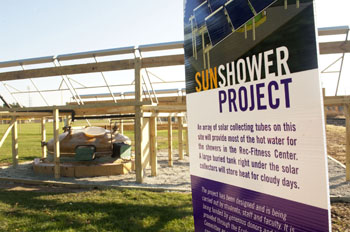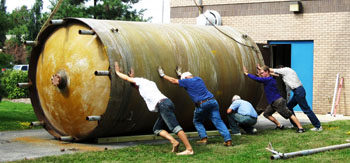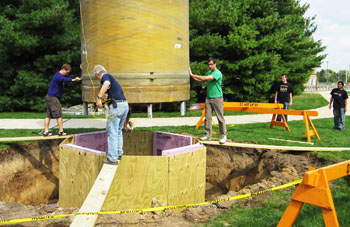Sun showers will pour from Goshen College’s Rec-Fitness Center

People taking showers in Goshen College’s Roman Gingerich Recreation-Fitness Center will soon have the sun – and the Goshen College Physics Department – to thank for their warm water. Members of the Sun Shower Collective, consisting of GC students, faculty and staff, planned and are building solar panels to heat the water in the RFC.
What started out as hypothetical brainstorming among physics students in the fall of 2008 is in the process of becoming reality. The final work on the solar panels is being completed, and the group expects the system to be up and running in a few weeks.
How it works
The project uses eight tube-style solar hot water collectors, said Isaac Yoder-Schrock, a senior physics major from Donnellson, Iowa, who is heavily involved in the project. The collectors absorb energy from the sun and heat the water that runs through them. This heated water is then stored in a large, well-insulated underground water tank. The insulated storage tank was installed in late September, southwest of the RFC. The water from the tank is transferred to the water entering the boiler in the RFC and preheats the cold water. Yoder-Schrock explained that this process causes the boiler to consume less natural gas.
One unique aspect of the design is that the storage tank stores up heat in order to get through many days of cloudy weather, said John Buschert, professor of physics. The storage tank, which the group bought on eBay, is designed to hold stratified layers of water for efficient heat storage. Once enough initial heat is established, solar energy will be used to heat the RFC water year round.
The group chose the RFC to use solar panels because it is one of the few buildings on campus that is used year round. For example, although the dorms use substantial water for showers during the school year, they don’t use any water during the summer months when they’re vacant.
Students have played a heavy role in most aspects of the project.
“While the project has been a collaboration between students, faculty and staff, students have been integral in the research, engineering, proposal-writing and construction of the project,” said Yoder-Schrock. The students completed the research, wrote the proposal, contacted many of the donors and worked alongside contractors to complete aspects of the construction.

This project was never formally linked with any classes, so students and faculty always worked on it on the side in addition to their class workloads. Buschert said at first it was hard to find the time and to stay on task with students going in and out. They needed students to commit to the project. That’s when Yoder-Schrock and Andrew Glick, a sophomore physics major from Pekin, Ill., stepped in.
“It’s unusual for students to be so heavily involved in such a big project,” said Buschert. “We only have a few pre-engineering students, so we put them to good work.”
This was also an opportunity for students to use problem-solving skills as obstacles arose amidst their research.
“It was really hard to get good numbers from the solar industry as a small, independent, non-business affiliated project,” said Glick. “Whether it was prices or the panel’s thermal energy ratings, we had to make a lot of phone calls and send a lot of emails and analyze the data we got back in order to try and make the best investment.”
Money was an obstacle, he said, but with the help of donors who were interested in supporting sustainability and a grant from the Ecological Stewardship Committee, they were able to make it work. Buschert said that although solar energy may not be the cheapest form of energy right now, this project isn’t just about money. Even if natural gas or other forms of energy are cheap, he said, “we’re still paying a different kind of price for it as we’re putting more and more carbon into the air.”
A step closer to carbon neutral
The main reason for completing this project is simple: it reduces the campus’ carbon footprint by using sustainable, clean energy. Money factor aside, the solar panels will help the college get one step closer to the goal of becoming a carbon neutral campus that Goshen College President Jim Brenneman set in 2007.

The new solar project is only the latest venture to reduce energy usage for Goshen College. Energy-reducing initiatives have included technical adjustments to systems, education of students and employees about what they can do to conserve, and more energy efficient construction and new purchases of equipment. For example, the college uses a computerized energy management system, which can control heating and cooling in rooms across campus based on detailed schedules of occupancy. There are timers, sensors and motion detectors to turn the lights off when rooms and hallways aren’t in use or the outside light is sufficient. Energy-efficient light bulbs are used across campus. And hot water temperatures are adjusted based on outdoor temperatures. Computerized controls of fans and pumps save significant amounts of energy.
From July 2010 to June 2011, the college used 5,160,00 kilowatt-hours (kwh) of electricity. This is the lowest electrical consumption since 1991-1992. During the same time, the college used 28,640.4 decatherms of gas. This is about 20 percent less natural gas consumed per year than the college was using in 1990. The college is using significantly less energy despite the fact that it has added 60 percent more square footage of building space since 1990, all of which needs to be heated and cooled.
“There are many facets to creating a more sustainable environment,” said Glenn Gilbert, sustainability coordinator and utilities manager. “Fortunately, conservation of finite resources and reduction in our carbon footprint often lines up with saving money and improving our quality of life. It takes imagination and creativity to bring this about and involves everyone doing their part. I am thankful that Goshen College has made this commitment and has chosen to be a leader in teaching and modeling ecological stewardship. The Sun Shower Collective is a perfect example.”
— By Alysha Landis




